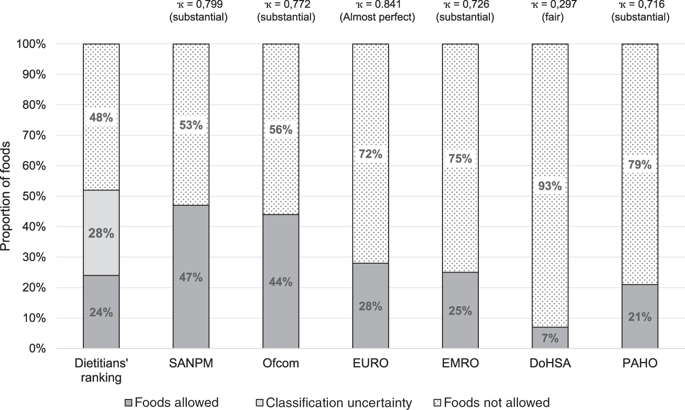当前位置:
X-MOL 学术
›
Eur. J. Clin. Nutr.
›
论文详情
Our official English website, www.x-mol.net, welcomes your
feedback! (Note: you will need to create a separate account there.)
Assessing the construct validity of nutrient profiling models for restricting the marketing of foods to children in South Africa.
European Journal of Clinical Nutrition ( IF 3.6 ) Pub Date : 2020-01-29 , DOI: 10.1038/s41430-020-0566-y Mariaan Wicks 1 , Hattie Wright 2 , Edelweiss Wentzel-Viljoen 1
European Journal of Clinical Nutrition ( IF 3.6 ) Pub Date : 2020-01-29 , DOI: 10.1038/s41430-020-0566-y Mariaan Wicks 1 , Hattie Wright 2 , Edelweiss Wentzel-Viljoen 1
Affiliation

|
BACKGROUND
In an effort to combat childhood obesity the WHO has called on governments to restrict the marketing of unhealthy foods to children. Regulators have turned to nutrient profiling (NP) to provide the evidence for their decisions. This has resulted in the development of NP models, of which the validity of only a few have been established. The aim of this study was to assess the construct validity of various NP models for the purpose of restricting the marketing of unhealthy foods to children in South Africa by comparing the classification of foods by the models to the ranking of the same foods by registered dietitians.
METHODS
Six current NP models were identified, then a representative food database of 120 foods was developed and each individual food was classified by each of the six models. Lastly dietitians were recruited to rank the healthfulness of the same 120 foods.
RESULTS
Dietitians allowed 24% of the included foods for marketing to children, whereas the percentage of foods allowed by the included models ranged from 7 to 47%. Majority of pairwise comparisons between the NP models and dietitians yielded ҡ statistics >0.6, indicating substantial agreement. An almost perfect pairwise agreement was found between dietitians and the WHO Regional Office for Europe model.
CONCLUSION
The included NP models displayed good construct validity by agreeing with dietitians on what are 'less healthy' foods, thus the foods not allowed for marketing. The findings of this study contributes to the process of establishing validity of NP models.
中文翻译:

评估用于限制向南非儿童销售食品的营养状况分析模型的构造效度。
背景技术为了与儿童肥胖症作斗争,世卫组织已呼吁政府限制向儿童销售不健康食品。监管机构已转向营养物分析(NP)为其决策提供依据。这导致了NP模型的发展,其中只有少数几个模型成立。这项研究的目的是通过比较模型对食物的分类与注册营养师对相同食物的排名来评估各种NP模型在限制向南非儿童销售不健康食物方面的有效性。方法确定了六个当前的NP模型,然后建立了具有代表性的120种食物的食物数据库,并通过这六个模型分别对每种食物进行了分类。最后,营养师被招募来对这120种食物的健康程度进行排名。结果营养师允许将其中24%的食品销售给儿童,而其中包括的模型所允许的食品百分比为7%至47%。NP模型和营养师之间的成对比较大多数结果显示,统计学> 0.6,表明基本一致。营养师和世界卫生组织欧洲区域办事处模型之间发现了几乎完美的成对协议。结论所包含的NP模型通过与营养学家就什么是“较不健康”的食物达成共识,从而显示出良好的结构效度,因此不允许在市场上出售这些食物。这项研究的发现有助于建立NP模型的有效性。结果营养师允许将其中24%的食品销售给儿童,而其中包括的模型所允许的食品百分比为7%至47%。NP模型和营养师之间的成对比较多数显示ҡ统计量> 0.6,表明基本一致。营养师和世界卫生组织欧洲区域办事处模型之间发现了几乎完美的成对协议。结论所包含的NP模型通过与营养学家就什么是“较不健康”的食物达成共识,从而显示出良好的结构效度,因此不允许在市场上出售这些食物。这项研究的发现有助于建立NP模型的有效性。结果营养师允许将其中24%的食品销售给儿童,而其中包括的模型所允许的食品百分比为7%至47%。NP模型和营养师之间的成对比较多数显示ҡ统计量> 0.6,表明基本一致。营养师和世界卫生组织欧洲区域办事处模型之间发现了几乎完美的成对协议。结论所包含的NP模型通过与营养学家就什么是“较不健康”的食物达成共识,从而显示出良好的结构效度,因此不允许在市场上出售这些食物。这项研究的发现有助于建立NP模型的有效性。NP模型和营养师之间的成对比较多数显示ҡ统计量> 0.6,表明基本一致。营养师和世界卫生组织欧洲区域办事处模型之间发现了几乎完美的成对协议。结论所包含的NP模型通过与营养学家就什么是“较不健康”的食物达成共识,从而显示出良好的结构效度,因此不允许在市场上出售这些食物。这项研究的发现有助于建立NP模型的有效性。NP模型和营养师之间的成对比较多数显示ҡ统计量> 0.6,表明基本一致。营养师和世界卫生组织欧洲区域办事处模型之间发现了几乎完美的成对协议。结论所包含的NP模型通过与营养学家就什么是“较不健康”的食物达成共识,从而显示出良好的结构效度,因此不允许在市场上出售这些食物。这项研究的发现有助于建立NP模型的有效性。因此,这些食物不得用于销售。这项研究的发现有助于建立NP模型的有效性。因此,这些食物不得用于销售。这项研究的发现有助于建立NP模型的有效性。
更新日期:2020-01-29
中文翻译:

评估用于限制向南非儿童销售食品的营养状况分析模型的构造效度。
背景技术为了与儿童肥胖症作斗争,世卫组织已呼吁政府限制向儿童销售不健康食品。监管机构已转向营养物分析(NP)为其决策提供依据。这导致了NP模型的发展,其中只有少数几个模型成立。这项研究的目的是通过比较模型对食物的分类与注册营养师对相同食物的排名来评估各种NP模型在限制向南非儿童销售不健康食物方面的有效性。方法确定了六个当前的NP模型,然后建立了具有代表性的120种食物的食物数据库,并通过这六个模型分别对每种食物进行了分类。最后,营养师被招募来对这120种食物的健康程度进行排名。结果营养师允许将其中24%的食品销售给儿童,而其中包括的模型所允许的食品百分比为7%至47%。NP模型和营养师之间的成对比较大多数结果显示,统计学> 0.6,表明基本一致。营养师和世界卫生组织欧洲区域办事处模型之间发现了几乎完美的成对协议。结论所包含的NP模型通过与营养学家就什么是“较不健康”的食物达成共识,从而显示出良好的结构效度,因此不允许在市场上出售这些食物。这项研究的发现有助于建立NP模型的有效性。结果营养师允许将其中24%的食品销售给儿童,而其中包括的模型所允许的食品百分比为7%至47%。NP模型和营养师之间的成对比较多数显示ҡ统计量> 0.6,表明基本一致。营养师和世界卫生组织欧洲区域办事处模型之间发现了几乎完美的成对协议。结论所包含的NP模型通过与营养学家就什么是“较不健康”的食物达成共识,从而显示出良好的结构效度,因此不允许在市场上出售这些食物。这项研究的发现有助于建立NP模型的有效性。结果营养师允许将其中24%的食品销售给儿童,而其中包括的模型所允许的食品百分比为7%至47%。NP模型和营养师之间的成对比较多数显示ҡ统计量> 0.6,表明基本一致。营养师和世界卫生组织欧洲区域办事处模型之间发现了几乎完美的成对协议。结论所包含的NP模型通过与营养学家就什么是“较不健康”的食物达成共识,从而显示出良好的结构效度,因此不允许在市场上出售这些食物。这项研究的发现有助于建立NP模型的有效性。NP模型和营养师之间的成对比较多数显示ҡ统计量> 0.6,表明基本一致。营养师和世界卫生组织欧洲区域办事处模型之间发现了几乎完美的成对协议。结论所包含的NP模型通过与营养学家就什么是“较不健康”的食物达成共识,从而显示出良好的结构效度,因此不允许在市场上出售这些食物。这项研究的发现有助于建立NP模型的有效性。NP模型和营养师之间的成对比较多数显示ҡ统计量> 0.6,表明基本一致。营养师和世界卫生组织欧洲区域办事处模型之间发现了几乎完美的成对协议。结论所包含的NP模型通过与营养学家就什么是“较不健康”的食物达成共识,从而显示出良好的结构效度,因此不允许在市场上出售这些食物。这项研究的发现有助于建立NP模型的有效性。因此,这些食物不得用于销售。这项研究的发现有助于建立NP模型的有效性。因此,这些食物不得用于销售。这项研究的发现有助于建立NP模型的有效性。











































 京公网安备 11010802027423号
京公网安备 11010802027423号